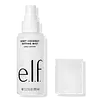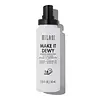What's inside
What's inside
 Key Ingredients
Key Ingredients

 Benefits
Benefits

 Concerns
Concerns

 Ingredients Side-by-side
Ingredients Side-by-side

Water
Skin ConditioningPolyurethane-35
Butylene Glycol
HumectantDipropylene Glycol
HumectantCocos Nucifera Oil
MaskingCocos Nucifera Water
MaskingTocopheryl Acetate
Antioxidant3-O-Ethyl Ascorbic Acid
Skin ConditioningCucumis Sativus Fruit Extract
EmollientCamellia Sinensis Leaf Extract
AntimicrobialPEG-40 Hydrogenated Castor Oil
EmulsifyingXanthan Gum
EmulsifyingPPG-26-Buteth-26
Skin ConditioningDisodium EDTA
Parfum
MaskingPhenoxyethanol
PreservativeEthylhexylglycerin
Skin ConditioningCaprylyl Glycol
EmollientMethylpropanediol
SolventPhenylpropanol
MaskingWater, Polyurethane-35, Butylene Glycol, Dipropylene Glycol, Cocos Nucifera Oil, Cocos Nucifera Water, Tocopheryl Acetate, 3-O-Ethyl Ascorbic Acid, Cucumis Sativus Fruit Extract, Camellia Sinensis Leaf Extract, PEG-40 Hydrogenated Castor Oil, Xanthan Gum, PPG-26-Buteth-26, Disodium EDTA, Parfum, Phenoxyethanol, Ethylhexylglycerin, Caprylyl Glycol, Methylpropanediol, Phenylpropanol
Water
Skin ConditioningCyclopentasiloxane
EmollientButylene Glycol
HumectantMethyl Trimethicone
Skin ConditioningSodium Chloride
MaskingPentylene Glycol
Skin ConditioningPhenoxyethanol
PreservativeCaffeine
Skin ConditioningCaprylyl Glucoside
CleansingHydrogenated Poly(C6-14 Olefin)
EmollientBenzophenone-9
UV AbsorberAlcohol Denat.
AntimicrobialTocopheryl Acetate
AntioxidantDisodium EDTA
Glycerin
HumectantParfum
MaskingCitrullus Lanatus Fruit Extract
Skin ConditioningGentiana Lutea Root Extract
Skin ConditioningAchillea Millefolium Extract
CleansingArtemisia Absinthium Extract
Skin ConditioningArnica Montana Flower Extract
MaskingPotassium Sorbate
PreservativeSodium Sorbate
PreservativeCitrulline
Skin ConditioningCI 15985
Cosmetic ColorantCI 17200
Cosmetic ColorantWater, Cyclopentasiloxane, Butylene Glycol, Methyl Trimethicone, Sodium Chloride, Pentylene Glycol, Phenoxyethanol, Caffeine, Caprylyl Glucoside, Hydrogenated Poly(C6-14 Olefin), Benzophenone-9, Alcohol Denat., Tocopheryl Acetate, Disodium EDTA, Glycerin, Parfum, Citrullus Lanatus Fruit Extract, Gentiana Lutea Root Extract, Achillea Millefolium Extract, Artemisia Absinthium Extract, Arnica Montana Flower Extract, Potassium Sorbate, Sodium Sorbate, Citrulline, CI 15985, CI 17200
Ingredients Explained
These ingredients are found in both products.
Ingredients higher up in an ingredient list are typically present in a larger amount.
Butylene Glycol (or BG) is used within cosmetic products for a few different reasons:
Overall, Butylene Glycol is a safe and well-rounded ingredient that works well with other ingredients.
Though this ingredient works well with most skin types, some people with sensitive skin may experience a reaction such as allergic rashes, closed comedones, or itchiness.
Learn more about Butylene GlycolDisodium EDTA plays a role in making products more stable by aiding other preservatives.
It is a chelating agent, meaning it neutralizes metal ions that may be found in a product.
Disodium EDTA is a salt of edetic acid and is found to be safe in cosmetic ingredients.
Learn more about Disodium EDTAParfum is a catch-all term for an ingredient or more that is used to give a scent to products.
Also called "fragrance", this ingredient can be a blend of hundreds of chemicals or plant oils. This means every product with "fragrance" or "parfum" in the ingredients list is a different mixture.
For instance, Habanolide is a proprietary trade name for a specific aroma chemical. When used as a fragrance ingredient in cosmetics, most aroma chemicals fall under the broad labeling category of “FRAGRANCE” or “PARFUM” according to EU and US regulations.
The term 'parfum' or 'fragrance' is not regulated in many countries. In many cases, it is up to the brand to define this term.
For instance, many brands choose to label themselves as "fragrance-free" because they are not using synthetic fragrances. However, their products may still contain ingredients such as essential oils that are considered a fragrance by INCI standards.
One example is Calendula flower extract. Calendula is an essential oil that still imparts a scent or 'fragrance'.
Depending on the blend, the ingredients in the mixture can cause allergies and sensitivities on the skin. Some ingredients that are known EU allergens include linalool and citronellol.
Parfum can also be used to mask or cover an unpleasant scent.
The bottom line is: not all fragrances/parfum/ingredients are created equally. If you are worried about fragrances, we recommend taking a closer look at an ingredient. And of course, we always recommend speaking with a professional.
Learn more about ParfumPhenoxyethanol is a preservative that has germicide, antimicrobial, and aromatic properties. Studies show that phenoxyethanol can prevent microbial growth. By itself, it has a scent that is similar to that of a rose.
It's often used in formulations along with Caprylyl Glycol to preserve the shelf life of products.
Tocopheryl Acetate is AKA Vitamin E. It is an antioxidant and protects your skin from free radicals. Free radicals damage the skin by breaking down collagen.
One study found using Tocopheryl Acetate with Vitamin C decreased the number of sunburned cells.
Tocopheryl Acetate is commonly found in both skincare and dietary supplements.
Learn more about Tocopheryl AcetateWater. It's the most common cosmetic ingredient of all. You'll usually see it at the top of ingredient lists, meaning that it makes up the largest part of the product.
So why is it so popular? Water most often acts as a solvent - this means that it helps dissolve other ingredients into the formulation.
You'll also recognize water as that liquid we all need to stay alive. If you see this, drink a glass of water. Stay hydrated!
Learn more about Water